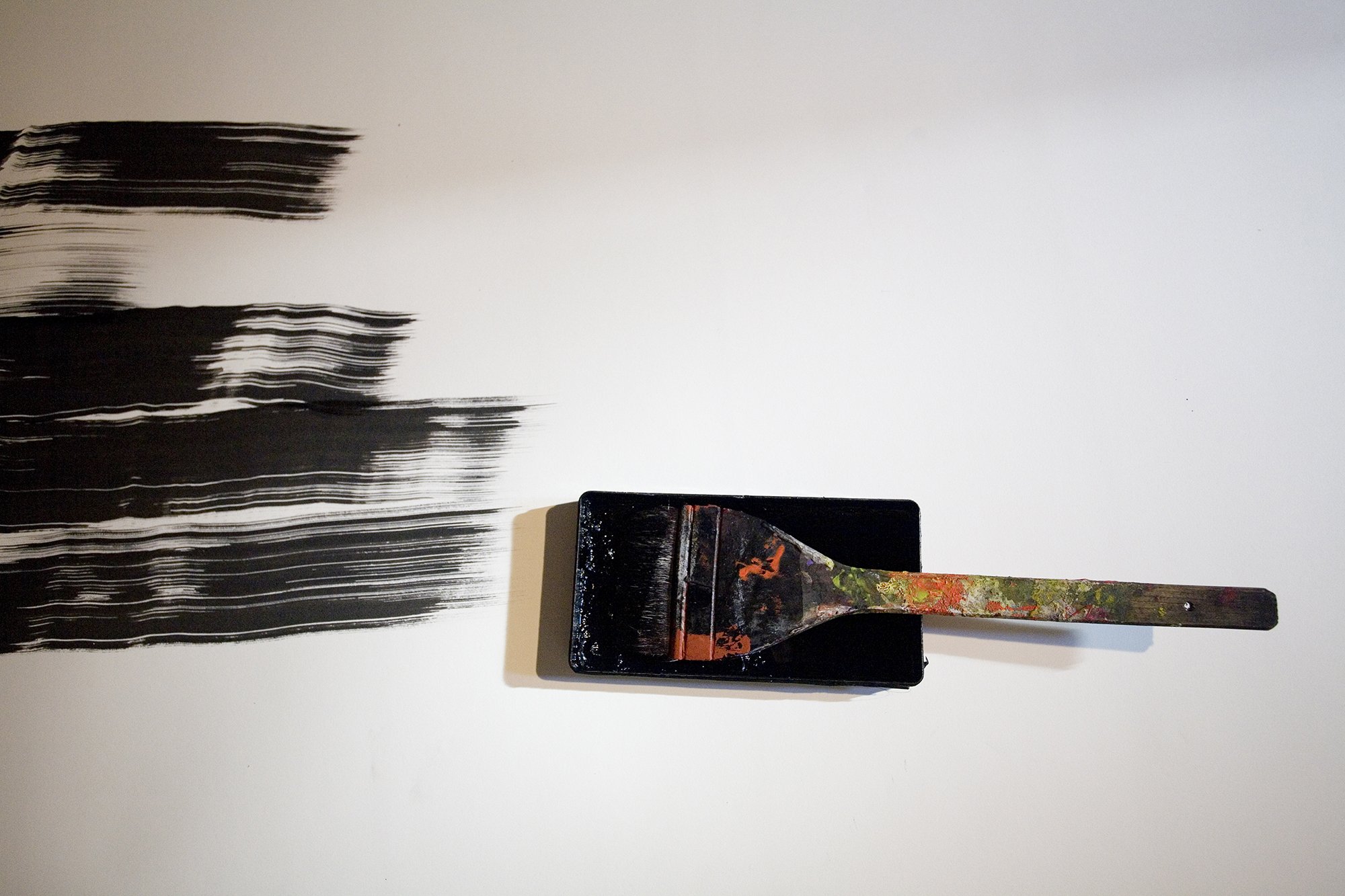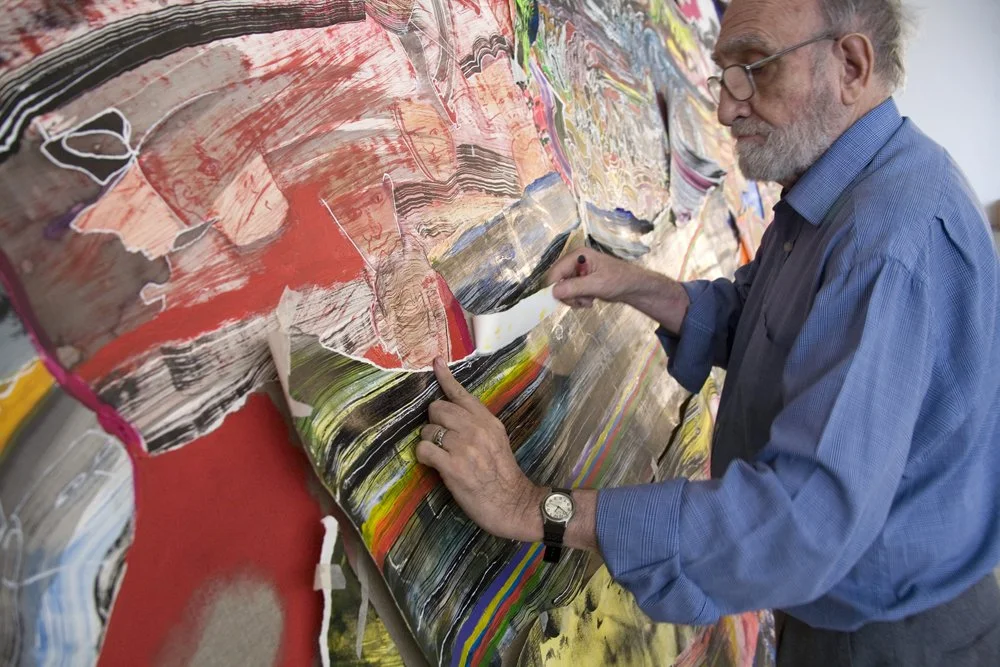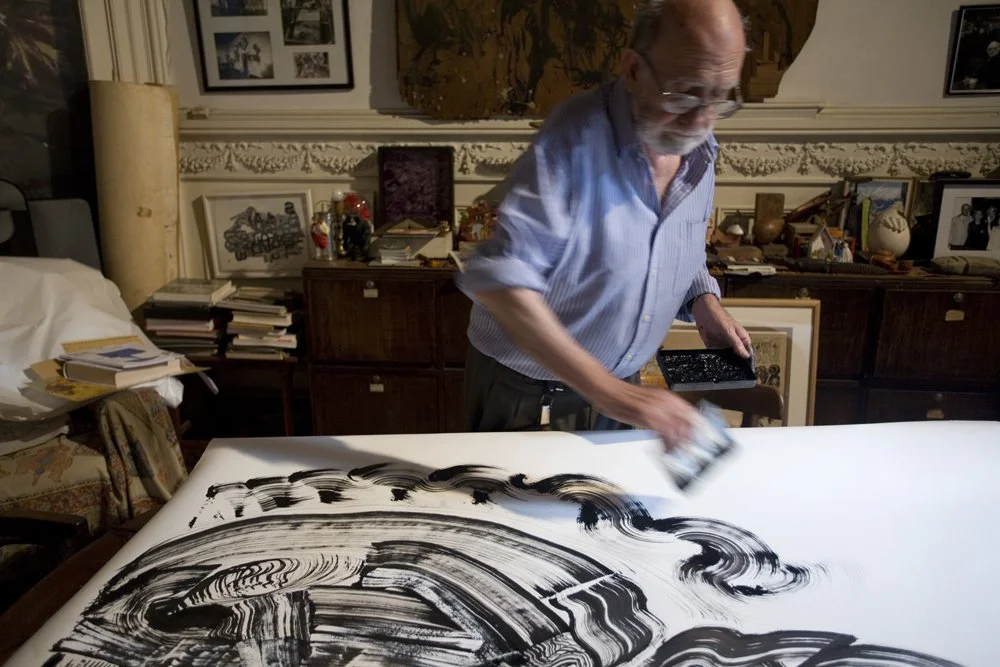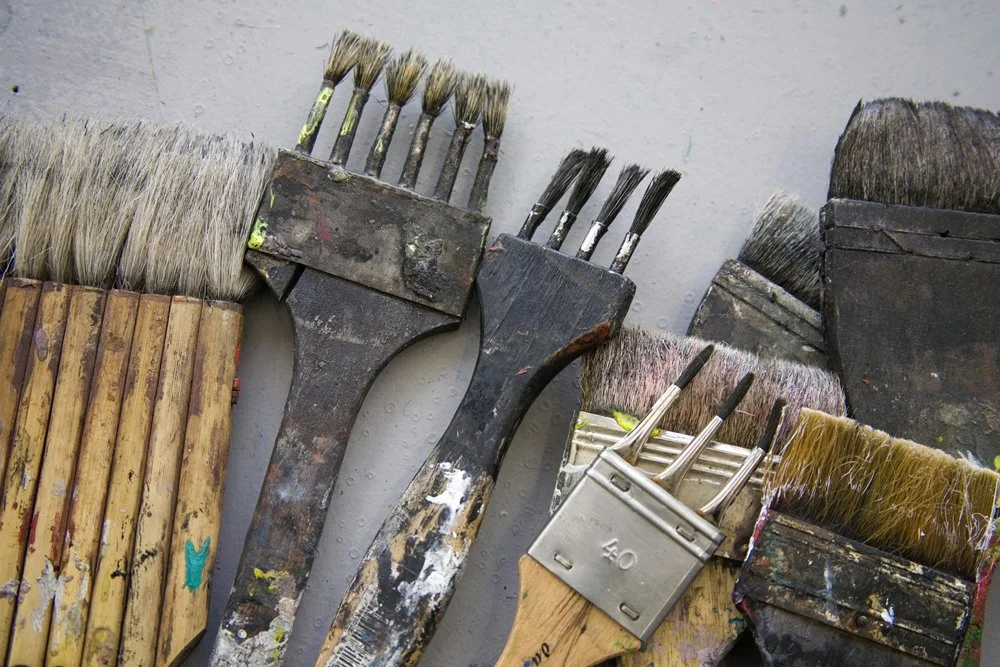
Dani’s Blog
Thank you, Yuyo. Safe travels in the au-delà
As with all passings, I have many emotions swirling. I have deep sadness, because he was such a generous artist and human, sharing so much of his time, vision and creativity. I had the great fortune to be able to photograph his process when he created his monumental work for the Venice Biennale in 2009.
Version français ci-dessous
I learned this week that Yuyo Noé has left his body. As with all passings, there are many emotions swirling. I have deep sadness, because he was such a generous artist and human, sharing so much of his time, vision and creativity. I had the great fortune to be able to photograph his process when he created his monumental work for the Venice Biennale in 2009.
Yuyo Noe at the Central Park studio in Barracas, Buenos Aires, working on Red/Net for the Venice Biennale.
He was 75 at the time, and worked late into the night, listening to Bach and drinking a gin & tonic. I could’ve watched him paint for hours, but at some point I’d go home, and when I came to the studio the next morning, I’d always be amazed by how much more he’d created after I left.
From those days in Argentina, spent with Yuyo and many other talented artists, I understood that when you spend your time making art, or anything that lights you up, on a daily basis, working from your heart and soul, it keeps you “young,” or rather feeling alive and purposeful. We talk about that a lot now, but easily forget. My time with these artists helped me see it, feel it, understand it. And in the years since that biennale, I saw Yuyo in Paris several times, and always felt like his creativity was a strong motor.
Yuyo painting late at night at his home on Tacuari, Buenos Aires.
Witnessing his work ethic was inspiring, and an example of dedication. Being in this kind of creative soup helped me give myself permission. His family was so different than my own. His daughter is an artist as well, and I’ve always felt like her art-making is a strong spark of life-force, something timeless in her. Whereas her family would consider her “day job” as a waste of time, and her art-making to be the real work, for my Midwestern American family it’s the opposite. The trick, I gather, is finding your own balance on your journey forward.
A moment in Yuyo’s process.
Watching Yuyo’s creative process opened up many doors to freedom in my mind. As he ripped off pieces of what he’d painted the night before, integrating it onto the large canvas, I almost held my breath. Observing him, I felt a childlike, “let’s try it! it’s fun!” but also saw a clear mastery and vision behind the act.

































As luck would have it, I showed up on the first day they began working at the re-converted match stick factory named Central Park, in Barracas, Buenos Aires. It was the day they draped the canvas onto its huge frame. My Spanish wasn’t so great, so throughout those three months, I made prints and distributed them to his team, to show what I was doing. This was before instagram and smart phones.
Yuyo in action one night, on a fresh roll of paper.
Some of Yuyo’s brushes.
It’s hard to select photos to share from my time documenting his work and process. There are so many.
In remembering Yuyo and his work, the warm family of friends that surrounded him and welcomed me, I have deep gratitude. It brought vibrant colors to my dreams and opened up doors of perception.
In my work, I put everything into a frame, with a certain obsession for geometry, which Cartier-Bresson said was necessary for a photographer. Being with Yuyo’s paintings, observing him creating, loosened my tight fist on geometry and relaxed my thirst for a certain order, learning to appreciate a different kind of order in chaos.
Yuyo adding details with a white pen.
Yuyo, wherever you are now, I wish you peace and joy, seeing how your work and care and vision expands through each person that you touched during your time here. Give a hug to your dear Nora. Thank you for opening your home, your studio, and your heart. I’ll pay it forward in your honour.
Merci, Yuyo. Bon voyage dans l’au-delà.
J’ai appris cette semaine que Yuyo Noé a quitté son corps. Comme pour chaque départ, un tourbillon d’émotions s’est levé. J’éprouve une grande tristesse, car c’était un artiste et un être humain d’une générosité rare, partageant tant de son temps, de sa vision et de sa créativité.
J’ai eu la grande chance de pouvoir photographier son processus lorsqu’il a créé son œuvre monumentale pour la Biennale de Venise en 2009.
Il avait alors 75 ans, et travaillait tard dans la nuit, écoutant Bach, un gin tonic à côté. J’aurais pu le regarder peindre pendant des heures, mais à un moment donné je rentrais chez moi, et le lendemain matin en revenant à l’atelier, j’étais toujours émerveillée par tout ce qu’il avait encore créé après mon départ.
Pendant ces journées passées en Argentine, avec Yuyo et de nombreux autres artistes talentueux, j’ai compris qu’en consacrant son quotidien à créer — à faire ce qui vous anime — avec le cœur et l’âme, on reste “jeune”, ou plutôt vivant et habité d’un sens profond. On en parle beaucoup aujourd’hui, mais on oublie vite. Le temps passé auprès de ces artistes m’a permis de le voir, le sentir, l’intégrer.
Et dans les années qui ont suivi cette biennale, j’ai revu Yuyo plusieurs fois à Paris, et j’ai toujours senti que sa créativité était un moteur puissant.
Être témoin de son éthique de travail était inspirant — un exemple de dévouement. Être plongée dans cette “soupe” créative m’a permis de m’autoriser à faire pareil. Sa famille était si différente de la mienne. Sa fille est aussi artiste, et j’ai toujours perçu dans sa pratique une étincelle vitale, une force intemporelle. Là où sa famille considérait son “job alimentaire” comme une perte de temps et sa pratique artistique comme le vrai travail, dans ma famille américaine du Midwest, c’était exactement l’inverse. Le défi, je crois, est de trouver son propre équilibre sur le chemin.
Observer le processus créatif de Yuyo a ouvert de nombreuses portes dans mon esprit. Lorsqu’il déchirait des morceaux de peinture de la veille pour les intégrer à la grande toile, je retenais presque mon souffle. En le regardant faire, je ressentais une joie enfantine — “allez, on essaie ! c’est marrant !” — mais je voyais aussi une maîtrise et une vision très claires derrière l’acte.
Le hasard a bien fait les choses : je suis arrivée le tout premier jour du travail à la fabrique d’allumettes reconvertie, appelée Central Park, à Barracas (Buenos Aires). C’était le jour où ils ont tendu la toile sur son énorme châssis. Mon espagnol n’était pas terrible à l’époque, alors pendant ces trois mois, j’ai tiré des épreuves que je distribuais à son équipe, pour montrer ce que je faisais. C’était avant Instagram et les smartphones…
C’est difficile de choisir quelles photos partager de ce moment passé à documenter son œuvre et son processus. Il y en a tant.
En me souvenant de Yuyo, de son travail, et de la chaleureuse famille d’amis qui l’entourait et m’a accueillie, je ressens une profonde gratitude. Cette période a mis des couleurs vives dans mes rêves et ouvert de nouvelles portes de perception.
Dans mon travail, j’ai toujours tout cadré avec une certaine obsession pour la géométrie — obsession que Cartier-Bresson disait nécessaire pour un·e photographe. Être auprès des toiles de Yuyo, le voir créer, a relâché cette crispation, détendu mon besoin de rigueur, et m’a appris à reconnaître un autre type d’ordre dans le chaos.
Yuyo, où que tu sois maintenant, je te souhaite la paix et la joie, en voyant combien ton œuvre, ta bienveillance et ta vision continuent à se diffuser à travers chaque personne que tu as touchée durant ton passage ici. Embrasse ta chère Nora. Merci d’avoir ouvert ta maison, ton atelier et ton cœur. Je continuerai à transmettre, en ton honneur.
Two weeks of Dirty Laundry @ 59 Rivoli
Tout s’est aligné comme si c’était écrit dans les étoiles.
L’idée s’est glissée dans mon esprit : pourquoi ne pas proposer une expo au 59 Rivoli ? (Un lieu avec lequel j’ai une longue histoire.)
Ma première réponse : oh, je n’ai pas le temps…
Mais silencieusement, dans un coin de ma tête : Et si je prenais le temps, je ferais quoi ? Et là, je l’ai vu tout de suite.
Version français ci-dessous
Photo by Alex Katar
It all came together as if written in the stars.
The idea was planted in my brain: why not propose an exhibition at 59 Rivoli ? (A place I have a long history with).
My response: Oh, I don’t have time…
But quietly in my mind: If I could make the time, what would I do?
I saw it right away. I’d build an exhibition with Zoe Duchesne and Vilma Pimenoff, feeling how our work would interact and communicate in this space. I contacted Vilma, who lives in Helsinki, and asked her if there was any chance she’d like to come to Paris and exhibit. The timing was perfect, she was coming for a two month residency at Cité des Arts. Awesome.
Then I contacted Zoe, not knowing that only a couple weeks prior, she’d written in her journal that she wanted to do more collective projects. Again, perfect timing.
It had been 7 years since I had shown anything from this body of work.
I was 4 months pregnant last time.
I quickly put together a proposal, and when the question about a title arose, the answer was already there. Dirty Laundry. I had this phrase in my collection of bits of writing, formed using cut-ups from magazines, “you are writing things like pieces of dirty laundry.” When the words had appeared in this sequence, it immediately felt like a warning or judgement from the realm of “shoulds.” Maybe I shouldn’t be writing these things. Maybe I shouldn’t be sharing these thoughts. Maybe I shouldn’t be expressing my feelings like this. Maybe I should keep this private. Maybe I’m wrong. Maybe my photos bother people. Or maybe I should put the doubts in the backseat and keep moving forward and see what happens!
Positioning our giant exhibition poster, designed by Matthieu Delahaie, in the window of 59 Rivoli. Vilma Pimenoff is outside guiding us to make sure it’s straight.
The impulse to create doesn’t go away. We’re inherently creative beings. Are there certain things we should not share? I have this idea that if I stay low, and don’t get knocked out by the auto-censor, and just make the damn work, there could be freedom and joy on the other side. (Ah, but do I have the right? my inner keep-it-safe-and-quiet critic says.) This is knocking up against a false belief that I need permission! It feels like I need a signed permission slip between me and joy!
Red thread corset
Anyway, let’s keep going. On the other side of the creative void, there could be connection with people who feel the same and understand, and maybe want to talk about it. That possibility is exciting enough to keep going.
This idea of airing your dirty laundry has brought up very diverse responses, making it clear that everyone has different degrees of comfort in how much personal stuff they share outside of their circle of close loved ones.
Here’s a short video of us talking about how we see Dirty Laundry, and a display of French spoken by a Quebecoise, Américaine and a Finlandaise!
Deux semaines de Dirty Laundry @ 59 Rivoli, Paris
Tout s’est aligné comme si c’était écrit dans les étoiles. L’idée s’est glissée dans mon esprit : pourquoi ne pas proposer une expo au 59 Rivoli ? (Un lieu avec lequel j’ai une longue histoire.)
Ma première réponse : oh, je n’ai pas le temps…
Mais silencieusement, dans un coin de ma tête : Et si je prenais le temps, je ferais quoi ?
Et là, je l’ai vu tout de suite. Je construirais une expo avec Zoé Duchesne et Vilma Pimenoff, sentant à quel point nos travaux pourraient dialoguer ensemble dans cet espace.
J’ai contacté Vilma, qui vit à Helsinki, pour lui demander si par hasard elle aurait envie de venir exposer à Paris. Le timing était parfait, elle arrivait pour une résidence de deux mois à la Cité des Arts. Génial.
Puis j’ai écrit à Zoé, sans savoir que quelques semaines plus tôt, elle avait noté dans son journal qu’elle voulait faire plus de projets collectifs. Encore une fois, timing parfait.
Cela faisait sept ans que je n’avais rien montré de cette série.
La dernière fois, j’étais enceinte de quatre mois.
J’ai rapidement monté un dossier, et quand la question du titre s’est posée, la réponse était déjà là. Dirty Laundry. J’avais cette phrase dans ma collection de textes découpés dans des magazines : “you are writing things like pieces of dirty laundry.” Quand ces mots sont apparus dans cet ordre, j’ai ressenti comme un avertissement, un jugement venu du royaume des “tu devrais”. Peut-être que je ne devrais pas écrire ça. Peut-être que je ne devrais pas partager ces pensées. Peut-être que je ne devrais pas exprimer mes émotions de cette façon. Peut-être que je devrais garder ça pour moi. Peut-être que j’ai tort. Peut-être que mes photos dérangent.
Ou peut-être que je devrais foutre tous ces doutes à l’arrière et avancer pour voir ce qui se passe.
L’impulsion de créer ne disparaît pas. On est des êtres créatifs, par nature. Est-ce qu’il y a des choses qu’on ne devrait pas partager ?
J’ai cette idée que si je reste basse, si je ne me fais pas assommer par l’auto-censeur, et que je fais juste le boulot, il pourrait y avoir de la liberté et de la joie de l’autre côté. (“Ah, mais est-ce que j’ai le droit ?” murmure ma petite voix prudente.)
Ça vient heurter cette croyance absurde que j’ai besoin d’une autorisation ! Comme s’il me fallait un mot signé entre moi et la joie !
Bref, continuons.
De l’autre côté du vide créatif, il y a peut-être des connexions à faire, avec d’autres personnes qui ressentent la même chose, qui comprennent, et qui peut-être veulent en parler. Et cette possibilité-là me donne envie d’avancer.
Cette idée d’“étaler son linge sale” a suscité des réactions très diverses, révélant à quel point chacun a un seuil différent en matière d’intimité, et de ce qu’il est prêt à partager en dehors de son cercle proche.
Electron Libre
Suisse Marocain (b. David Hardy) is a German artist who was born in the air between Tangiers and Geneva. When he’s not off traveling and collaborating with artists in Sicily and Madagascar, Germany or Portugal, he lives in Paris. If you see him here in the winter, he usually has a good tan, choosing his déplacements wisely. He’s a person who lives and wears his art. Put him inside the Musée Igor Balut, his ever-evolving installation in his studio on the 4th floor of 59 rue de Rivoli, and he’ll seem to disappear.
Version français ci-dessous
Suisse Marocain
Suisse Marocain (b. David Hardy) is a German artist who was born in the air between Tangiers and Geneva. When he’s not off traveling and collaborating with artists in Sicily and Madagascar, Germany or Portugal, he lives in Paris. If you see him here in the winter, he usually has a good tan, choosing his déplacements wisely. He’s a person who lives and wears his art. Put him inside the Musée Igor Balut, his ever-evolving installation in his studio on the 4th floor of 59 rue de Rivoli, and he’ll seem to disappear.
Suisse inside his installation at the Vagabond Gallery show in a pop-up store-front space on rue des Saint Pères, Paris.
When I think of Suisse, aside from his incredible dimples, I think of freedom. Freedom of expression in fashion, painting, collaboration, performance. I’ve seen him wearing pink knit legwarmers, a harlequin-printed jumpsuit, a top hat with a red heart on top (my favorite), and usually clothing he or another artist has painted on. His playfulness says, “c’est pas grave” just have fun with it all, we don’t have to be so serious all the time, here’s a paint brush.
An average day at the atelier on rue de la Tour des Dames, in the 9th, where the artists at 59. Rivoli were temporarily relocated for three years.
Suisse is one of the original residents of the well-known squat in the center of Paris at 59 rue de Rivoli that began in 1999, was bought by the city who renovated it from 2006-2009. During that time, the city gave the artists a space to use in the 9th on rue de la Tour des Dames. After renovating 59, the artists returned and now pay a nominal rent, for their studio space and the building re-opened to the public on 09-09-2009.
I became friends with Suisse when I hung around photographing in 2006 while they moved the entire 6 floors of studios over to the one-floor space in the 9th.
“I came to tell you I’m leaving,” the title of a Serge Gainsbourg song painted on the walls of the former Musée Igor Balut, on one of the last days in the old version of 59 rue de Rivoli. Suisse Marocain can be seen walking into his old studio, through doorways that have since been torn down. Paris, 2006.
When you’re at 59 Rivoli, you’re enveloped in an energy of “something is about to happen.” It’s an adult fun house where the paintings don’t end at the borders of their canvases and there is always live music being played somewhere. The entire place is a collaborative installation, or as my friend Holden calls it, “an art zoo.”
Being open to the public, it has become a major Paris tourist attraction. If you stay there for an entire day, you meet a lot of people (artists, musicians, curious people, and some who are lost and want to be pointed toward the Louvre or the Notre Dame). As Suisse has been working there for over a decade, he’s made a lot of connections and often helps bring over artists from Lisbon, Madagascar, Italy, Germany and elsewhere to collaborate here and hold exhibitions.
Suisse & collaborative painting on a truck during Nuit Blanche, Paris, 2010.
I had a small studio at 59 in 2009/2010, around the corner from Suisse. During that time, a part of my practice became devoted to self-portraiture, which began by using elements from Musée Igor Balut. At that time, his generosity encouraged me to claim space that I may never have asked for let alone taken, without having him metaphorically open the door and say, have a look in there, you can work here you know, we’ll make room for you. Last summer I was looking for a studio and he cleared out a corner for me to use while he was in Sicily working and doing his under-water art show, an installation of artwork that requires viewers go diving in goggles to discover his work. Because, why not? With Suisse, anything is possible.
Hanging around during the 2nd move, from rue de la Tour des Dames back to 59 rue de Rivoli. Paris, 2009.
Suisse Marocain (né David Hardy) est un artiste allemand, né dans l’air entre Tanger et Genève. Quand il ne voyage pas pour collaborer avec d’autres artistes en Sicile, à Madagascar, en Allemagne ou au Portugal, il vit à Paris. Si vous le croisez ici en hiver, il a généralement un joli bronzage — il choisit bien ses déplacements. C’est un être qui vit et porte son art. Mettez-le dans le Musée Igor Balut, son installation en constante évolution nichée dans son atelier au 4e étage du 59 rue de Rivoli, et il semblera se fondre dans le décor.
Quand je pense à Suisse, au-delà de ses fossettes incroyables, je pense à la liberté. Liberté d’expression dans la mode, la peinture, la collaboration, la performance. Je l’ai vu porter des jambières tricotées roses, une combinaison imprimée arlequin, un haut-de-forme orné d’un cœur rouge (mon préféré), et souvent des vêtements peints par lui ou par d’autres artistes. Sa légèreté semble dire : « C’est pas grave », amuse-toi, on n’est pas obligés d’être sérieux tout le temps. Tiens, voilà un pinceau.
Suisse est l’un des résidents d’origine du célèbre squat du 59 rue de Rivoli, en plein cœur de Paris, qui a vu le jour en 1999, puis a été racheté par la Ville et rénové entre 2006 et 2009. Pendant les travaux, la mairie a attribué aux artistes un espace temporaire rue de la Tour des Dames, dans le 9e arrondissement. Après la rénovation, les artistes ont pu revenir, payant un loyer symbolique pour leurs ateliers. Le lieu a rouvert au public le 09-09-2009.
J’ai rencontré Suisse en 2006, en traînant là-bas pour faire des photos, à l’époque où ils déménageaient tout le contenu des six étages dans un espace temporaire d’un seul niveau dans le 9e.
Quand on est au 59 Rivoli, on sent cette énergie particulière : quelque chose est sur le point d’arriver. C’est une maison de jeux pour adultes, où les peintures débordent des toiles et où il y a toujours de la musique quelque part. L’endroit tout entier est une installation collaborative, ou comme dit mon ami Holden, « un zoo artistique ».
Ouvert au public, le lieu est devenu une véritable attraction touristique à Paris. Si tu y passes une journée entière, tu croises une foule de gens (artistes, musiciens, curieux, et parfois des touristes perdus qui cherchent leur chemin vers le Louvre ou Notre-Dame). En travaillant là depuis plus de dix ans, Suisse a noué des tas de contacts, et il aide régulièrement des artistes venus de Lisbonne, de Madagascar, d’Italie, d’Allemagne ou d’ailleurs à exposer et collaborer au 59.
J’ai eu un petit atelier au 59 en 2009/2010, juste à côté de celui de Suisse. C’est là qu’une partie de ma pratique artistique a pris un tournant vers l’autoportrait, en utilisant certains éléments de son Musée Igor Balut. À ce moment-là, sa générosité m’a permis de m’emparer d’un espace que je n’aurais peut-être jamais osé réclamer, encore moins occuper. Il a, en quelque sorte, ouvert une porte en me disant : regarde par ici, tu peux travailler là si tu veux, on va te faire de la place.
L’été dernier, je cherchais un atelier. Il m’a dégagé un coin dans le sien pendant qu’il était en Sicile, en train de travailler et de présenter son exposition d’art sous-marin — une installation à découvrir en plongeant avec masque et tuba. Parce que… pourquoi pas ?
Avec Suisse, tout est possible.
















